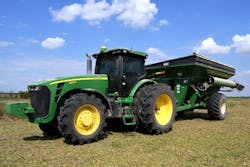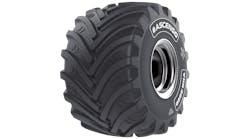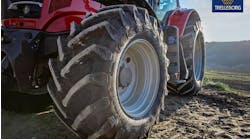Modern Tire Dealer has partnered with AG Tire Talk to provide answers to insightful questions that farm tire dealers have about farm tire technology. This is the next installment in our ongoing series, which is designed to help farm tire dealers better connect with their customers. A trending question, followed by answers, will appear in our Commercial Tire Dealer section every other month. For complete answers, click on www.agtiretalk.com.
QUESTION: Why are ag tires so difficult to find, why are prices increasing, how long will this continue and what should producers do to make sure they have the tires they need?
DAVE PAULK, manager, field technical services, BKT USA: The tire industry has been faced with many difficulties over the last 18 months during COVID-19. Although agricultural tires have been in demand as farmers have received government subsidies and invested in farming equipment, manufacturers are challenged to keep up with demand.
There have been many complications getting the raw materials needed to produce tires because of restrictions imposed during and after the shutdowns from the pandemic. Rubber and other raw material prices continue to increase month over month.
Getting tires to customers is also a challenge. For the logistics industry, there has been a shortage of containers, with estimated 12.5% of the global capacity being unavailable. Shipping and freight costs are escalating almost daily. There is a shortage of laborers at the ports, as well as truck drivers for transportation. Containers of tires that have already arrived at ports are many times held up for several extra weeks before reaching the customers.
Concurrently, there is a new energy crisis and due to shortages, coal futures are soaring, with an increase of more than 200%. These macro-economic factors of the market are certainly creating barriers. Many tire manufacturers had to cut down on production to adjust to the changing environment. The greater challenge for them is to adapt and keep on the move.
BKT is working closely with our distributors and dealers to ensure that they receive the tires they need to cover current demand and order effectively for future needs.
DANA BERGER, ag business development manager, Continental Commercial Specialty Tires: We have all seen the effects of the COVID-19 pandemic in one way or another. The pandemic shut down many key operations and material supply for tires. Steel, natural rubber, carbon black silica - the list goes on. And all of the materials are not sourced from one place, either.
Add to this the challenges we have faced through logistics channels, at ports, with trucking companies and their driver shortages and don't forget to factor in all industry labor shortages. It's truly amazing that tires were manufactured, let alone made it to wholesalers, distributors, dealers and end users. If we had to count the individuals involved from start to finish - from sourcing materials for production to mounting a tire to a tractor - we would lose count.
In March 2020, the planting season was already planned for and who knew we would be approaching the 2022 planting season learning to make pandemic life "normal?" Keep in mind, farmers are considered essential workers. Even when many were working from home, farmers were out using their tires. Plant shutdowns didn't happen on any farm.
As with any commodity, the law of supply and demand comes into play. When there is high demand and low supply, prices always go up. The only challenge with this is that market demand hasn't decreased, despite price increases. Enter demand-pull inflation, where demand for tires exceeds the manufacturer's capacity. This creates a great challenge for sales.
Salespeople put in long hours planting the seed with a new customer - growing their interest and building rapport - before they can reap the reward. To not have tires to sell is a painful topic to share with those seedling customers. What is even harder is not knowing how long the industry will continue to be affected. Several countries are now facing another variant of COVID-19, expos are being postponed again and some are being cancelled, even now.
We certainly don't want to see this demand-pull effect be the norm, but it's very hard to say when this situation will level out. Farmers will need to plan ahead as much as possible. If they find the right size tire in stock and expect to need a replacement, they should jump on it. Original equipment manufacturers also have struggled with a shortage of resources and getting new equipment to the farmers. This will keep demand for replacement tires at a high level, at least into 2023, with brand loyalty not carrying much weight until some relief can be seen on the horizon.
GREG GILLAND, vice president, global agriculture, Maxam Tire North America: The agricultural tire market is facing unparalleled demand and is up significantly versus the same period last year. The primary factor for this incredible leap in demand is core crop prices for 2021. Despite the economic impacts of the COVID-19 pandemic of 2020, we have experienced almost a doubling of crop prices in less than 15 months, beginning in the second half of 2020. This explosion of demand is primarily centered on the global need for wheat, soybeans, corn and cotton.
Improved profits for farmers and growers have fueled unprecedented global demand for new equipment and/or tires for their vehicles. This has accelerated new equipment demand from the original equipment manufacturers, which has severely strained the global tire supply as manufacturers are reacting to the combined tire surge in both original equipment and aftermarket needs.
As we look at 2022 and beyond, these are the trends we are observing. OEM demand for tires will remain high as tire manufacturers react to their factory needs well into 2022; farmers and growers will need to purchase equipment and tires to amortize their 2021 profits earned; cash crop prices are expected to remain high
well into the first quarter of 2023, which will allow more farmers to purchase equipment or tires into the first half of 2023; and the global population continues to grow, which will create a permanent strain on food supply for the years to come.
In addition, the current global delays caused by container or port distribution and/or ground freight problems — with no end in sight — will artificially continue to drive tire demand, as well sustain current crop prices.
Farmers and growers need to remain proactive and monitor all of their equipment needs to include tires. In this case, proactive means farmers and growers must be placing orders now for what they think they may need in the next six-months-to-a-year away.
Maxam’s objective in the years to come is to grow our tire production capacity so we can continue to deliver radial products in the right sizes with the right load capabilities, that when operated at the right air pressure, will deliver the value our customers expect.
DAVID GRADEN, operational market manager, agriculture, Michelin North America Inc.: As many of us know, replacement tire demand can be driven by many different factors. If I were to prioritize those factors, I would say seasonal weather, net farm income and global agricultural economics would be at the very top.
Of course, we can’t always plan for the weather, but to some extent, we can keep our thumbs on projected net farm income and global agricultural economics. As ag tire manufacturers, we manage our forecasted demand based upon these two projections, plus historical hits/misses and what we see in farming practice evolution.
To explain what is occurring today, we need to look back to the beginning of COVID-19. Farmers who were negatively affected tended to rely heavily upon manual/migrant workers and/or grow and supply foods to our schools, restaurants and businesses. All other farmers and producers were affected very little, but still received COVID-19 financial relief. This — in addition to low input costs — are a big piece of the net farm income equation that led to more spending.
Unfortunately, from a manufacturing perspective, the entire world almost completely shut down for four to eight weeks, while we all continued to feed ourselves and others. In a normal year, ag tire plants have to build constantly in order to keep up with demand. By the third and fourth quarters of 2020, all ag tire manufacturers were playing catch-up, while demand continued to increase.
In early-2021, we began to see major shortages of raw materials like nylon and rubber. To further compound these issues, we began to see more cargo ships catching up and carrying more cargo, fewer trucks and truck drivers, massive increases in goods due to the spike in demand caused by the influx of cash into our economy, etc. We have been and are currently living in a snowball that continues to evolve.
Jump ahead to today and replacement ag tire demand has continued to be strong, while net farm income is beginning to flatten, input costs are rising and COVID-19 relief is still being paid out. Unfortunately, we are all still experiencing higher raw material costs, while shipping container costs went from $3,000 to $18,000. Trucks and truck drivers are still very limited and labor costs have skyrocketed. Manufacturers of all shapes and sizes have to raise prices to cover these additional costs and even are finding creative ways to solve the logistic issues. Some ag tire manufacturers are curbing their demand by increasing prices, while others are cancelling orders and charging more for logistics. Either way, the light at the end of this tunnel is still a bit dim.
We will see some relief around the late second half of 2022. Pricing will still be high and campaigns will be few and far between, but supply is improving. Michelin is maneuvering through this very fluid situation on a daily basis, as I am sure our competitors are doing the very same.
NORBERTO HERBENER, OE applications engineer, Trelleborg Wheel Systems: Ag tires have been difficult to find because of several factors. With the pandemic in full swing in early-2020, customers hesitated in any kind of tire purchase because of the uncertainty as to what was to happen. Tractor production stopped and some tire production stopped, creating future pent-up demand. The ag tire market does go in cycles and 2021 caught up the cycle.
The tire industry also is suffering a similar problem to other industries — a labor shortage. Many people are not working and because tire building is a skilled service, laborers are difficult to find. With fewer people making tires, factory output is lower.
On the other hand, crop yield has been good. More than 14 billion bushels of corn were produced in the U.S. in 2020. That’s a 9% increase (from 2019 levels). Commodity prices also are high.
Producers realized a large windfall from 2020 and this triggered spending. Tractor manufacturers could not keep up with the sudden influx of tractor orders. Consequently, tire manufacturers could not keep up with the sudden influx of orders from tractor manufacturers.
Producers should place orders right now with their tire dealers. And we suggest that tire dealers place orders with manufacturers to get in line when tires become available.
BLAINE COX, national product manager, agriculture, golf and turf, Yokohama Off-Highway Tires America Inc.: Many farm tires have been hard to find over the past year or so due to supply chain constraints at every level, from sourcing raw materials to shipping finished tires to dealers. Supply chain challenges have also contributed to high raw material prices, which have been a major factor in driving up tire costs. The bad news is that economists say it will be months or longer before today’s constraints let up.
One of the great benefits of working for a company that specializes in farm and other OTR tires is that the off-road lines don’t get pushed aside by the demands of larger markets like passenger or light truck tires. Our factories are dedicated to OTR and our team members are experts in keeping those lines moving.
When supplies are tight and costs are increasing, it also really pays off for customers to know their tire dealer and trust that he or she is going to be able to get them the tires they need for the job they’re doing.
This is not the time to skimp on tires and figure there will be a replacement around if something goes wrong. Selling a quality tire that’s purpose-built and application-specific for your customers’ equipment and conditions is the best way to ensure long, reliable service. This is a time when trust, expertise and relationships really pay off more than ever.



